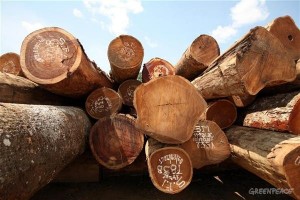
Afrormosia (Pericopsis elata) is a rare variety of tropical tree valued worldwide for its usefulness as beautiful interior hardwoods. Since 1992, Afrormosia has been listed under Appendix II of the Convention of International Trade in Endangered Species of Wild Fauna and Flora (CITES), which concerns species that experts fear could verge on extinction if their trade is unrestricted.
In July 2014, CIEL, Greenpeace, Global Witness, and the Environmental Investigation Agency expressed our concerns about exports of illegally harvested Afrormosia from the Democratic Republic of Congo (DRC), and its treatment of Afrormosia under Annex II, at the CITES Standing Committee, and these concerns remain.

The recently released 2015 export quota for Afrormosia shows that, unfortunately, little has changed with respect to timber exports from DRC. Based on inventories which were completed for only 9 out of the total 23 logging titles, the 2015 quota was increased to 23,240 m3—nearly the same as the 25,000 m3 quotas for 2012-2014—and it remains to be seen whether the 2015 quota will increase during the next several months based on completion of other inventories. Moreover, these inventories mean very little for the legality of the actual exports of Afrormosia. In fact, the notification CITES made to the parties last year that export permits should be checked for “validity” by the Secretariat may have in effect provided cover to questionable imports.
In April 2014, the CITES Secretariat notified parties of a “large number of fake or falsified permits apparently issued by the Democratic Republic of the Congo,” requested that Parties contact the Secretariat to confirm the validity of any CITES permits from DRC before acceptance, and provided a long list of “permits . . . that are unaccounted for.”
Based on the notification, it was not clear what measures the Secretariat was undertaking to verify the validity of permits, so we contacted them to get more information. In the CITES Secretariat’s response it is apparent that the verification process means very little with regard to whether or not the timber is legal. It only means the Secretariat checks whether the permit was issued by the DRC Management Authority. Although the Secretariat states they check that there are no “obvious indications of illegal trade” they mean as far as they can see on the permit itself, but do not check other sources. The CITES Secretariat takes no responsibility for and does not check the legality of the wood covered by the CITES permit because it is not within their mandate. They emphasize that this is the task of the DRC Management Authority. This letter from the Secretariat is further evidence that CITES does not actually stop trade in illegal timber under its permit system, which is particularly problematic since the EUTR designates timber with a CITES permit as fully legal on its markets.
For example, the Independent Monitoring of Forest Law Enforcement and Governance (IM-FLEG) in DRC and external monitors have found that the six companies authorized to export Afrormosia from DRC have engaged in illegal logging activities over the past few years. The last IM-FLEG report from the heart of the Afrormosia range in province Orientale, makes it clear that the forest sector is not only in chaos, but the chaos is organized and the government is not enforcing its own laws. Bearing in mind there is no operational and credible traceability system in place in the DRC, assuring legal compliance—an obligation under CITES rules—seems a near impossible task.
As exports under the 2015 quota commence, CITES permits for imports of timber species should not be taken as pro forma evidence of legality in either the US or EU. To this end, EU officials should use the new January 15, 2015 regulation, which provides a clear legal basis to refuse to issue an import permit when legality of the timber cannot be confirmed based on information provided by the exporting country. The EU and US CITES authorities should go further than just checking if the paperwork accompanying Afrormosia shipments is correct. They need to understand the reality on the ground and at a bare minimum use existing information from IM-FLEG reports and external forest monitors on illegal logging to assess whether an import permit can be given.
Originally posted on February 24, 2015.
